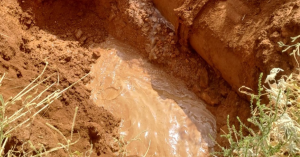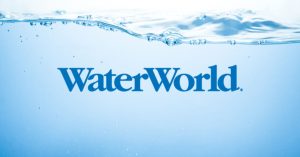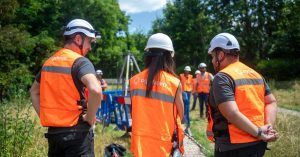More than 40 per cent of Europe is suffering from some form of water scarcity, according to the latest update from the European Drought Observatory. Even traditionally water-abundant countries like Ireland and France are facing challenges. Dublin, for example, relies on the Liffey River for most of its drinking water, but more than 30 per cent is lost before it reaches customer taps. Meanwhile, the OECD predicts that the Paris region is at increasing risk of drought following water restrictions in 2018 and record supply deficits in 2022.
Now, European utilities, including Uisce Éireann (Ireland’s national utility) and SEDIF (France’s largest public water service), are turning to innovative AI-driven technology to help them tackle the problem of leakage in water supply networks.
Drought conditions are increasing in Europe
A recent update from the EU’s European Drought Observatory found that between 11 and 20 May (2025), more than 41 per cent of Europe found itself in some form of drought condition.
These drought conditions now extend beyond traditional hotspots to countries and regions historically considered water-secure, such as Poland, Ukraine, France, and Germany. This shift demonstrates how climate change is reshaping water availability across the continent.
Ireland: A wet but water-scarce land
While Ireland is not currently experiencing drought conditions – though a recent dry spell saw it placed on the warning list by the European Drought Observatory – it is suffering from water scarcity, which means that supply is struggling to keep up with demand.
Ireland faces water scarcity due to changing rainfall patterns – more winter rain and less summer rain – combined with geographic challenges where most rain falls on the west coast while demand centres on the drier east.
In early May, Uisce Éireann (Ireland’s national water utility) issued its earliest ever water conservation orders.
With the capital city located on the drier eastern seaboard and with more than a quarter of the country’s total population living there, water demand is extremely high. As much as 80 per cent of the city’s drinking water supply is extracted from the Liffey, a figure that increases when looking at the Greater Dublin area. This reliance on the Liffey exposes the entire Dublin region to vulnerabilities caused by drought or pollution events.
“At 132km long, it’s probably one of the most important rivers in the country from a water supply perspective,” says Alan Milton, head of water network management at Uisce Éireann. “And it supplies drinking water to two million people in the greater Dublin area, along with a host of industries.”
Five times more water is taken from the Liffey than from any other river in Ireland.
“It’s a really important river to us and it’s something we have to do our best to save, to maintain a sustainable water supply to the greater Dublin area,” added Milton.
Nautilus: Detecting and Diagnosing Simultaneously
Uisce Éireann predicts that by 2044, the Greater Dublin Area will require 34 per cent more water than is currently available, due to factors such as economic growth, population growth, and the impact of climate change.
Ireland’s major cities, including Dublin and Cork, rely heavily on 19th-century infrastructure for delivering drinking water. Every day across Ireland, more than 30 per cent of all treated water is lost before it reaches customers’ taps because of leaking pipes.
In a water-abundant country, this volume of water lost to leaks would be a problem; in a water-scarce country, it becomes a huge issue. However, identifying that there has been a leak or that there is a current leak is difficult, and that is before trying to locate the leak to try and fix it.
With thousands of kilometres of ageing pipes, often in hard-to-access or remote locations, leak location is challenging and expensive work. Having already made significant reductions, Uisce Éireann found the challenge was becoming tougher.
“We’re finding now, once we’ve gotten to that 30-33 per cent, it gets harder to get further,” begins Milton. “It’s the old saying, ‘what got you here won’t get you there’. So, we knew we needed to do something a little bit different.”
With increasing demand and greater exposure to vulnerability, Uisce Éireann has already begun work on a project that is addressing water lost through leakage.
Gearing up for the war on leakage
To address the challenge of going ‘further’, Uisce Éireann started ‘horizon scanning’ for suitable partners and technologies. One of its latest collaborations is a replenish project with the Spanish water-tech company, Aganova, as part of a wider partnership with Suez and Microsoft – the project complements Microsoft’s global target to become water positive by 2030.
The water network in the Greater Dublin area comprises approximately 10,000km of water mains, of which 2,500 are trunk mains. For the project, a decision was made to look only at the trunk main areas with the highest levels of leakage.
“We have ambitious targets to get down to 20 per cent lost in the greater Dublin area. and 25 per cent nationally by 2030,” Milton states. “We’ve got to do something a little bit different and embrace new technologies, like AI, to help us in that journey and with the ‘war on leakage’ as we call it.”
Replenishment in the Greater Dublin area
“We have significant leakage targets and Aganova and Suez have the technologies, and it felt just a real perfect fit for all of us to come together to work on what amounts to a replenishment project in the Greater Dublin area,” adds Milton.
Uisce Éireann currently takes 600 million litres of water from the Liffey to service the needs of the greater Dublin area. If the amount of water that’s escaping from the network is reduced, it means less water will need to be taken from the Liffey.
Uisce Éireann is using Aganova’s Nautilus system to detect leaks and provide condition assessments of the trunk mains. Milton and Uisce Éireann were already familiar with similar technology.
“In this project, Aganova is focused exclusively on large diameter pipes,” explains Marcos Barrera, Chief Operating Officer at Aganova. “Assessing the condition of such big pipes was challenging in the past from a technology standpoint. So new technologies have been developed to allow these types of studies and surveys, which is also allowing our project partners to tackle water leaks on Dublin’s large-diameter pipes.”
Barrera adds: “The approach is unique because our technology is allowing us to recover water through leak detection and repair, but at the same time, we are leveraging the information we get from the inside of the pipe to provide information about the condition of the pipe. This proactive maintenance condition assessment can save millions in decision-making related to maintenance and pipe-related investments.”
The challenges in Dublin highlight a broader European trend: legacy infrastructure is no longer enough to meet 21st-century water demands. That’s why advanced, sensor-based diagnostics are gaining momentum.
Paris: A parallel challenge
The challenges facing Dublin are mirrored across Europe. In Paris, the region faces increasing drought risk following water restrictions in 2018 and record supply deficits in 2022, according to OECD predictions. SEDIF, France’s largest public water utility, manages 8,000km of network infrastructure serving 4.8 million users across seven departments in the region.
Although the Paris region has lower leakage rates than global averages, reducing water loss remains critical for tackling increasing water stress. Many of the region’s feeder pipes were installed between 1960 and 1990, and until recently, there has been little data available on their condition.
Using AI to address water loss in Paris
In June 2025, SEDIF awarded Aganova a five-year contract to inspect the network using its Nautilus technology, which scored highest during a rigorous evaluation where technical performance counted for 70 per cent of the decision, beating multiple international competitors.
The contract will focus on approximately 800km of critical large-diameter feeder pipes (>300mm diameter) that transport water to major distribution points, with Aganova’s superior diagnostic capabilities providing precise condition data to prioritise infrastructure investments.
“This partnership with Aganova represents our continued investment in cutting-edge diagnostic technology that enables us to optimise our network management and make data-driven investment decisions,” said Delphine Alrivie, Network Asset Management Project Manager at SEDIF.
Marcos Barrera says: “This is a significant milestone for Aganova. We are pleased to be working with SEDIF, France’s largest public water service and one of the largest in Europe. The scale of this infrastructure assessment showcases our technology’s ability to provide the precise condition data that utilities need to make informed investment decisions and prevent costly failures.”
Real-time detection of leaks and condition assessment
Capable of travelling up to 35km along large pipes each day, the Nautilus is a spherical device the size of a large orange equipped with acoustic sensors. It utilises AI-driven analysis that provides precise detection of leaks, accurate to under one metre. It also provides flowrate measurements to determine the severity of the leak and, pressure profiling and highlights early warning signs of corrosion and cracks.
Marcos Barrera explains why their approach is unique: “In water distribution, there are two assets, one is water, the other is the pipe. We take care of them both; we detect leaks and we assess the condition of the pipes as well.”
By tracking leak formation and pinpointing where the leak has occurred, and by offering an effective assessment of trunk main conditions to predict where a leak is likely to occur, utility engineers can ensure a speedy and proactive response with minimal disruption.
Beyond operational benefits, reducing the volume of water lost to leaks will help combat water scarcity issues both in the present and in the future. And while leak detection is only part of the solution to Europe’s ongoing water security, it helps to build resilience in the current system while stabilising supply for communities and industry.
As utilities across Europe face mounting pressure from climate change and ageing infrastructure, innovative technologies like Aganova’s AI-driven leak detection offer a pathway to more sustainable water management and improved resilience for millions of users.







